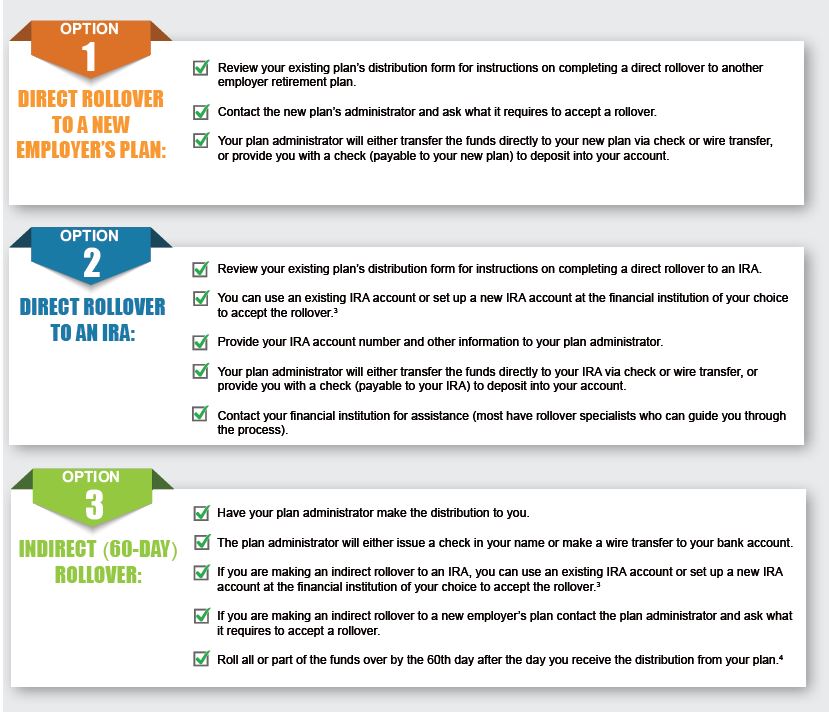There are two types of rollovers: direct and indirect. A direct rollover is paid from your plan directly to your IRA or to your new employer’s retirement plan. The funds are never payable to you. An indirect (60-day) rollover is a payment made to you that you later roll over to an IRA or an employer retirement plan.1 When you request a distribution from your employer’s 401(k), 403(b), or governmental 457(b) plan that’s eligible for rollover, you’ll receive a statement describing the tax rules applicable to your distribution and your rollover options.2 You should read that statement carefully.
- There are two major disadvantages to indirect rollovers. First, your plan is required to withhold 20% of the taxable portion of your payment for federal income taxes. You’ll get credit for that amount when you file your federal income tax return, but if you want to roll over the entire distribution, you’ll have to come up with the 20% that was withheld from other sources. Second, you run the risk of missing the 60-day deadline, which would make your distribution taxable. On the plus side, you’ll have use of the funds for up to 60 days. In general, direct rollovers are the safer choice.
- You cannot roll over hardship withdrawals, required minimum distributions, substantially equal periodic payments, corrective distributions, and certain other payments. Nonspousal death benefits can be rolled over only to an inherited IRA, and only in a direct rollover or trustee-to-trustee transfer. You may have the option of leaving your funds in your employer’s plan — consult your plan’s terms.
- You do not need to set up a special “Rollover IRA” account (sometimes called a “conduit IRA”) to receive your rollover, although some financial firms may require that you do so at least initially. (You can always transfer the funds to a different IRA account later.) While not required, in some cases a separate rollover IRA may be helpful if: (a) you think you may want to roll the taxable portion of your distribution back to an employer plan at some future date, or (b) you’re concerned about protection from creditors, as funds rolled over from an employer plan (and any earnings on those funds) generally receive unlimited protection under federal law if you declare bankruptcy.
- The IRS may waive the 60-day requirement where the failure to do so would be against equity or good conscience, such as in the event of a casualty, disaster, or other event beyond your reasonable control. There are three ways to obtain a waiver of the 60-day rollover requirement: (a) you qualify for an automatic waiver, (b) you self-certify that you met the requirements of a waiver, or (c) you request and receive a private letter ruling granting a waiver. Consult a tax professional.
Note: If you receive employer stock or other securities as part of your distribution be sure to understand the tax consequences before making a rollover to an IRA. Your distribution may be entitled to favorable net unrealized appreciation (NUA) tax rules. Consult a tax professional.
Broadridge Investor Communication Solutions, Inc. does not provide investment, tax, legal, or retirement advice or recommendations. The information presented here is not specific to any individual's personal circumstances.
To the extent that this material concerns tax matters, it is not intended or written to be used, and cannot be used, by a taxpayer for the purpose of avoiding penalties that may be imposed by law. Each taxpayer should seek independent advice from a tax professional based on his or her individual circumstances.
These materials are provided for general information and educational purposes based upon publicly available information from sources believed to be reliable — we cannot assure the accuracy or completeness of these materials. The information in these materials may change at any time and without notice.


